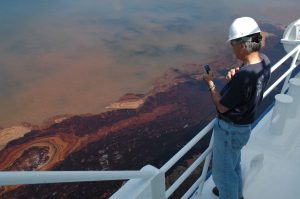Southern Miss Maintains Vigorous Research Five Years After BP Oil Spill
– April 20, 2015
The Deepwater Horizon oil rig explosion that occurred on April 20, 2010 not only triggered an unprecedented contamination of the northern Gulf of Mexico, but also yielded an unparalleled research effort to gauge the effects of the massive oil spill.
(From 7WDAM) — Five years after the largest environmental disaster in U.S. history, scientists at The University of Southern Mississippi continue to lead the way in mapping and analyzing the oil spill’s effects on the Gulf waters’ fragile ecosystem.
“I don’t think anyone involved in the aftermath of this disaster really understood the magnitude of what took place. It wasn’t the sort of thing you could imagine happening,” said Dr. Monty Graham, chair of the Department of Marine Science at Southern Miss. “Nobody has completely wrapped his or her arms around everything associated with the oil spill. Five years later we are still making new discoveries tied to the spill, and this will most likely continue for decades to come.”
The British Petroleum-leased Deepwater Horizon platform was drilling approximately 50 miles southeast of the Louisiana coast when an explosion and subsequent fire destroyed the rig. Eleven people died in the blast and 17 others were injured. The explosion ruptured a well beneath the water’s surface, creating an oil leak that lasted 87 days. More than 200 million gallons of crude oil was pumped into the Gulf of Mexico, affecting 16,000 total miles of coastline from Florida to Texas.
Almost immediately USM scientists from the Gulf Coast Research Laboratory (GCRL) and Stennis Space Center began investigating and processing the damage caused by the spill. Less than two weeks after the disaster, the University assembled an Oil Spill Response Team to coordinate the University’s efforts in monitoring the spill’s repercussions.
“USM has been at the forefront of the oil spill research almost since day one,” said Dr. Read Hendon, director of the Center for Fisheries Research and Development at GCRL. “Having the northern Gulf of Mexico quite literally in our own backyard positioned us strategically and practically to be a lead institution in studying the spill.
“That, coupled with USM’s diverse range of expertise in marine and coastal sciences, has allowed the University to serve a prominent role in this process over the last five years. That role will continue, and likely expand, in the coming years as we strengthen our scientific capacity along the Mississippi Gulf Coast.”
Hendon points out that Southern Miss scientists have secured funding to study the spill’s effects from a variety of sources, including: the National Science Foundation Rapid Response Program, the Gulf of Mexico Research Initiative, the National Fish and Wildlife Foundation’s Gulf Environmental Benefit Fund, and the Natural Resources Damage Assessment – at both the state and federal levels.
Southern Miss faculty members have published dozens of peer-reviewed papers related to the oil spill and many of those have been cited numerous times. A paper submitted by Dr. Arne Diercks, assistant research professor in the Department of Marine Science, (Diercks, A.R., R.C. Highsmith, V.L. Asper, D. Joung, Z. Zhou, L. Guo, A.M. Shiller, S.B. Joye, A.P. Teske, N. Guinasso, T.L. Wade, and S.E. Lohrenz, 2010. Characterization of subsurface polycyclic aromatic hydrocarbons at the Deepwater Horizon site. Geophysical Research Letters 37: L20602, doi:10.1029/2010GL045046.) was the first to document the submerged plume of oil/gas deep beneath the ocean surface. The Diercks et al. paper has been cited more than 90 times in the past five years.
“There has been considerable USM research that examined the fate of the oil/gas that was dispersed,” said Dr. Alan Shiller, director of the Center for Trace Analysis in the Department of Marine Science. “This included papers examining the microbial bloom which consumed the submerged gas plume, nutrient distributions that may have controlled the microbial bloom, and carbon isotopes in plants and animals as indicators of what became of the hydrocarbons that were metabolized.”
Continued monitoring and research of the spill led to the formation of the Center for Gulf Studies (CGS) in 2013. The Center serves as a focal point for new, long-term research and socioeconomic initiatives along the northern Gulf of Mexico.
Read the full article here: http://www.wdam.com/story/28841824/southern-miss-maintains-vigorous-research-five-years-after-bp-oil-spill
GoMRI “In the news” is a reposting of articles about GoMRI-funded research (published by various news outlets). The author’s interpretations and opinions expressed in these articles is not necessarily that of GoMRI.






